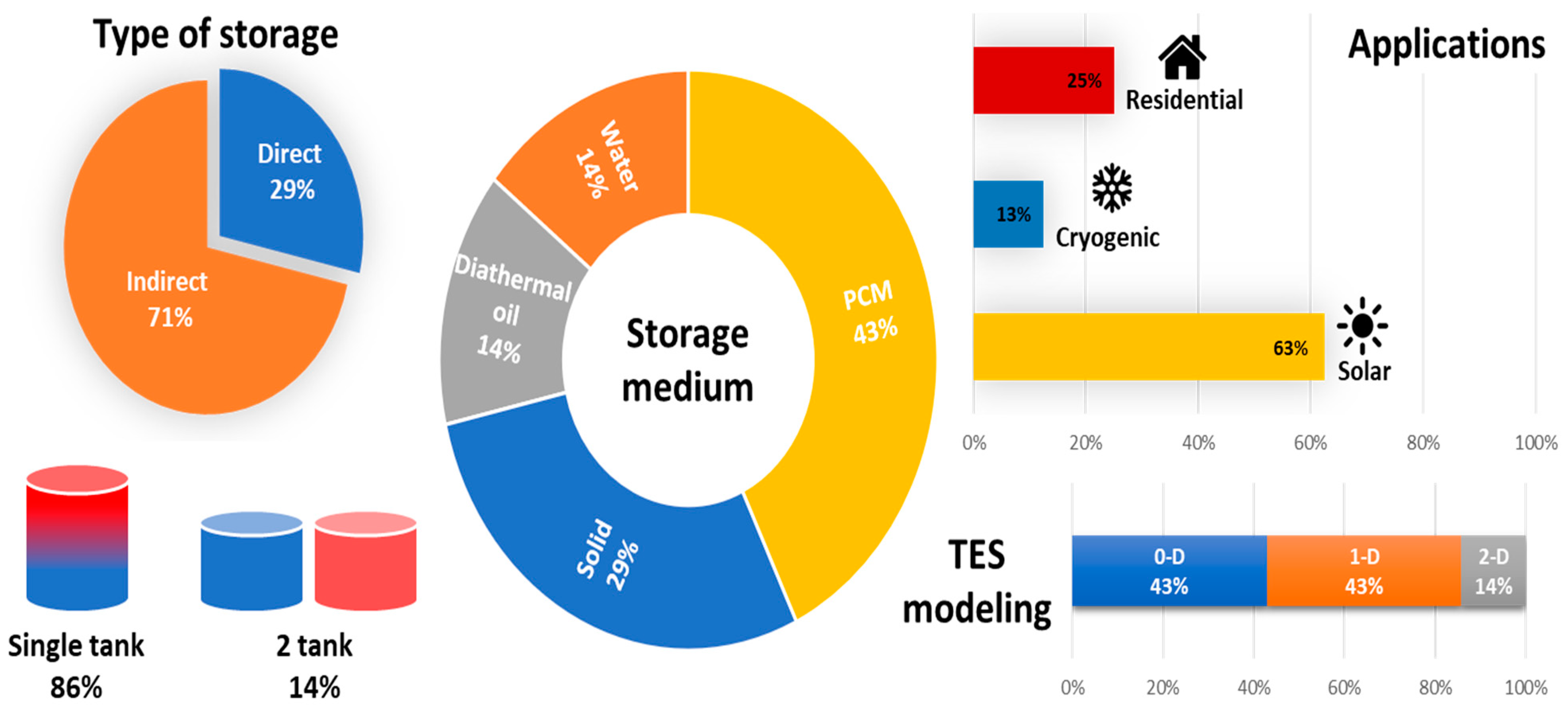Modeling, Optimization and Testing of Thermal Energy Storage Systems and Their Integration in Energy Conversion Processes
- concentrating solar power (CSP),
- combined cold, heat and power (CHP, CCHP),
- compressed air energy storage (CAES, ACAES),
- power-to-X,
- waste heat recovery,
- carbon capture utilization and storage (CCUS),
- solar cooling.
- The response to the call for this Special Issue was good, with the following statistics:
- Publications: (8);
- Article Types: Review Article (0); Research Article (8).
- Authors’ geographical distribution (affiliation of authors):
- Belgium,
- Canada,
- Denmark,
- Germany,
- Italy,
- Malaysia,
- Pakistan,
- Saudi Arabia,
- the UK.
Funding
Institutional Review Board Statement
Informed Consent Statement
Data Availability Statement
Conflicts of Interest
References
- Tascioni, R.; Arteconi, A.; Del Zotto, L.; Cioccolanti, L. Fuzzy Logic Energy Management Strategy of a Multiple Latent Heat Thermal Storage in a Small-Scale Concentrated Solar Power Plant. Energies 2020, 13, 2733. [Google Scholar] [CrossRef]
- Cinocca, A.; Di Bartolomeo, M.; Cipollone, R.; Carapellucci, R. A Definitive Model of a Small-Scale Concentrated Solar Power Hybrid Plant Using Air as Heat Transfer Fluid with a Thermal Storage Section and ORC Plants for Energy Recovery. Energies 2020, 13, 4741. [Google Scholar] [CrossRef]
- Sattar, A.; Farooq, M.; Amjad, M.; Saeed, M.A.; Nawaz, S.; Mujtaba, M.A.; Anwar, S.; El-Sherbeeny, A.M.; Soudagar, M.E.M.; Filho, E.P.B.; et al. Performance Evaluation of a Direct Absorption Collector for Solar Thermal Energy Conversion. Energies 2020, 13, 4956. [Google Scholar] [CrossRef]
- Cameretti, M.C.; Cappiello, A.; De Robbio, R.; Tuccillo, R. Comparison between Hydrogen and Syngas Fuels in an Integrated Micro Gas Turbine/Solar Field with Storage. Energies 2020, 13, 4764. [Google Scholar] [CrossRef]
- Tola, V.; Arena, S.; Cascetta, M.; Cau, G. Numerical Investigation on a Packed-Bed LHTES System Integrated into a Micro Electrical and Thermal Grid. Energies 2020, 13, 2018. [Google Scholar] [CrossRef] [Green Version]
- Hemmatabady, H.; Formhals, J.; Welsch, B.; Schulte, D.O.; Sass, I. Optimized Layouts of Borehole Thermal Energy Storage Systems in 4th Generation Grids. Energies 2020, 13, 4405. [Google Scholar] [CrossRef]
- Fong, M.; Kurnia, J.; Sasmito, A.P. Application of Phase Change Material-Based Thermal Capacitor in Double Tube Heat Exchanger—A Numerical Investigation. Energies 2020, 13, 4327. [Google Scholar] [CrossRef]
- Morgan, R.; Rota, C.; Pike-Wilson, E.; Gardhouse, T.; Quinn, C. The Modelling and Experimental Validation of a Cryogenic Packed Bed Regenerator for Liquid Air Energy Storage Applications. Energies 2020, 13, 5155. [Google Scholar] [CrossRef]

Publisher’s Note: MDPI stays neutral with regard to jurisdictional claims in published maps and institutional affiliations. |
© 2022 by the authors. Licensee MDPI, Basel, Switzerland. This article is an open access article distributed under the terms and conditions of the Creative Commons Attribution (CC BY) license (https://creativecommons.org/licenses/by/4.0/).
Share and Cite
Cau, G.; Petrollese, M.; Tola, V. Modeling, Optimization and Testing of Thermal Energy Storage Systems and Their Integration in Energy Conversion Processes. Energies 2022, 15, 1121. https://doi.org/10.3390/en15031121
Cau G, Petrollese M, Tola V. Modeling, Optimization and Testing of Thermal Energy Storage Systems and Their Integration in Energy Conversion Processes. Energies. 2022; 15(3):1121. https://doi.org/10.3390/en15031121
Chicago/Turabian StyleCau, Giorgio, Mario Petrollese, and Vittorio Tola. 2022. "Modeling, Optimization and Testing of Thermal Energy Storage Systems and Their Integration in Energy Conversion Processes" Energies 15, no. 3: 1121. https://doi.org/10.3390/en15031121
APA StyleCau, G., Petrollese, M., & Tola, V. (2022). Modeling, Optimization and Testing of Thermal Energy Storage Systems and Their Integration in Energy Conversion Processes. Energies, 15(3), 1121. https://doi.org/10.3390/en15031121





